Pottery Wheels Under $500 vs Professional Models | The Real Differences
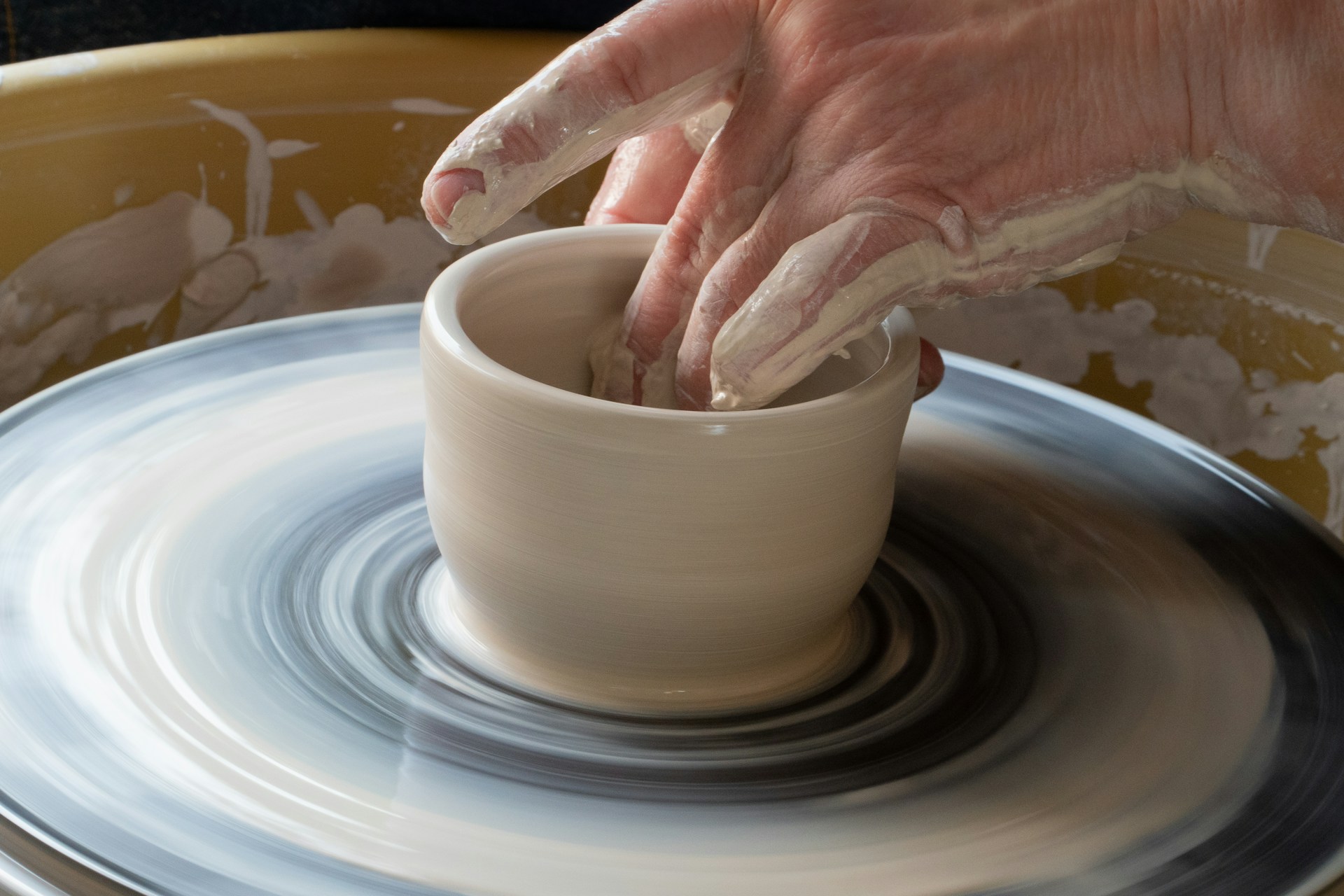
Twenty-five pounds of clay looks like a small watermelon. It's enough for a serving bowl that could hold pasta for a dinner party, a vase tall enough to hide a wine bottle, or about fifty failed attempts at centering. Most pottery wheels claim they handle 20-25 pounds. The VIVOHOME says 20. The Speedball Artista says 25. The Brent B says 150 - continuously. These numbers reveal more about motor quality than any horsepower rating. They separate wheels that slow under pressure from wheels that maintain speed regardless of what's happening above them.
The pottery wheel market splits into a strange paradox. The budget VIVOHOME machines on Amazon accumulate five-star reviews from people throwing their first wobbly bowls, right alongside one-star warnings about motors burning out after eight uses. Meanwhile, the Shimpo VL-Whisper runs so quietly you can hear clay particles realigning, and the Brent B handles 150 pounds of clay continuously - a specification that sounds absurd until you understand it means the motor never strains at normal loads. The space between these extremes tells the real story of modern pottery.
The specifications read like poetry to engineers and gibberish to everyone else. A 25-pound centering capacity translates to enough clay for a serving bowl that could hold Thanksgiving stuffing for twelve. That 1/2 HP motor rating on the Shimpo? It determines whether your wheel maintains speed when you lean into shaping or starts dying like a tired lawn mower. The VEVOR's height adjustment ranges from ground level to 6 inches - which sounds minor until you've spent four hours hunched over a fixed-height wheel, learning that pottery is apparently a contact sport for your spine.
Walking through today's pottery wheel landscape reveals different philosophies of making. The experimental tier - those sub-$200 wheels where wobble and motor noise become part of the experience, though users discover if clay interests them. The working middle - machines like the Speedball Artista that balance capability with cost. The professional bridge - where the Shimpo VL-Whisper proves that silence can be engineered. And the production tier - where Brent builds machines for professional use, with warranties measured in decades rather than months. Each tier serves different purposes. The market reflects different relationships with the craft.
The Working Middle: Where Most Pottery Actually Happens
The Speedball Artista occupies interesting territory. At its current price point on Amazon, it sits between the disposable experiments and the serious studio equipment, trying to be both accessible and capable. The machine comes from Speedball, a company that's been making art supplies since 1899 - longer than anyone's been throwing on electric wheels.
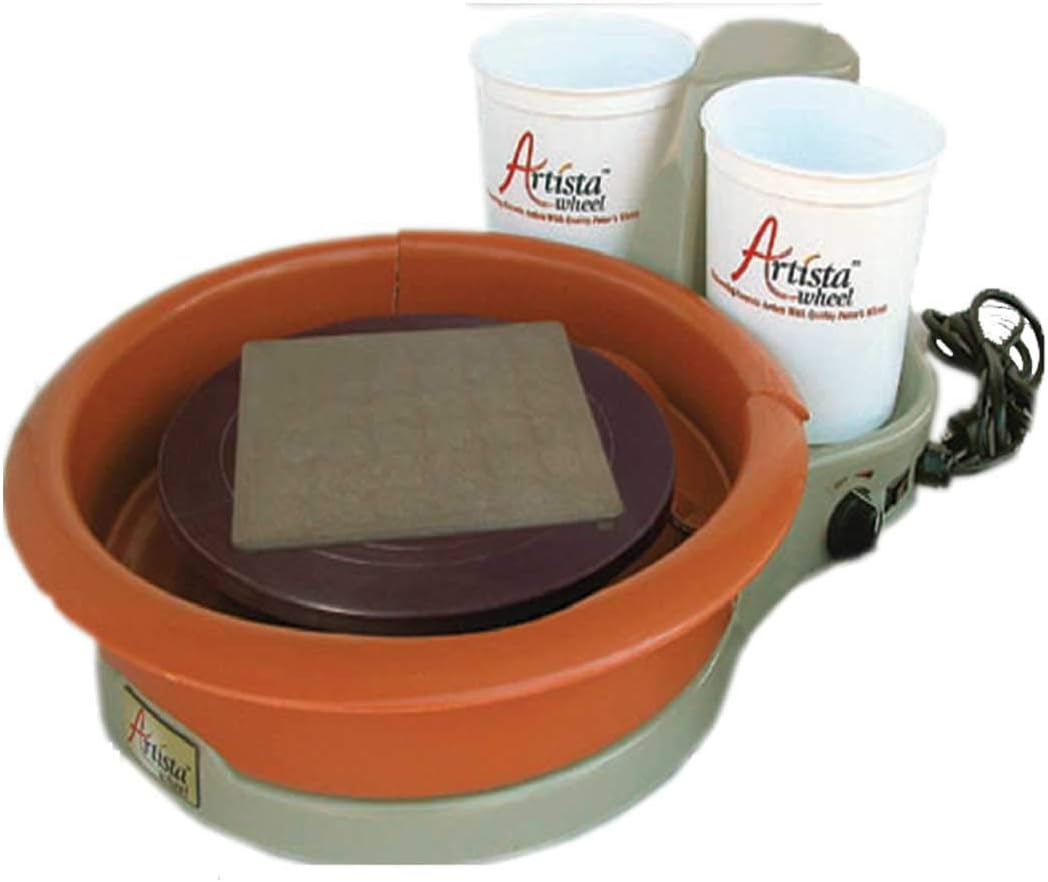
The numbers that matter: 1/3 HP motor, 11-inch wheel head, 25-pound centering capacity, 0-220 RPM variable speed. In practice, this means you can throw a large mixing bowl without the motor protesting, though you'll probably spend your first year making things that fit in your palm. The reviews tell a familiar story - 72 ratings averaging 4.1 stars, with the predictable split between "perfect for beginners" and "developed issues after a few months." The truth, as usual, lives somewhere between.
- 1/3 HP motor with 25 lb centering capacity
- 11-inch wheel head (no bat pins mentioned in current model)
- Variable speed hand control (0-220 RPM)
- Two-part splash pan
- Lightweight and portable design
- Runs with minimal noise according to manufacturer
The two-part splash pan deserves mention. Most budget wheels use fixed pans that turn cleanup into archaeology. The Artista's pan lifts away in sections. You're looking at five minutes of cleaning instead of twenty. These details accumulate. After throwing a dozen pieces, that saved time means something.
Most beginners find hand control easier initially, eliminating the coordination challenge between feet and hands. The lack of bat pins on the current model means working directly on the wheel head - a limitation that creates waiting time between pieces.
The Professional Bridge: Shimpo's Whisper Series
The Shimpo VL-Whisper occupies fascinating territory - priced like a used car but engineered like laboratory equipment. At its current price point, it's what happens when engineers decide pottery wheels need to be perfect rather than profitable. The machine barely whispers while running, hence the name, though calling near-silence a "whisper" undersells the engineering achievement.
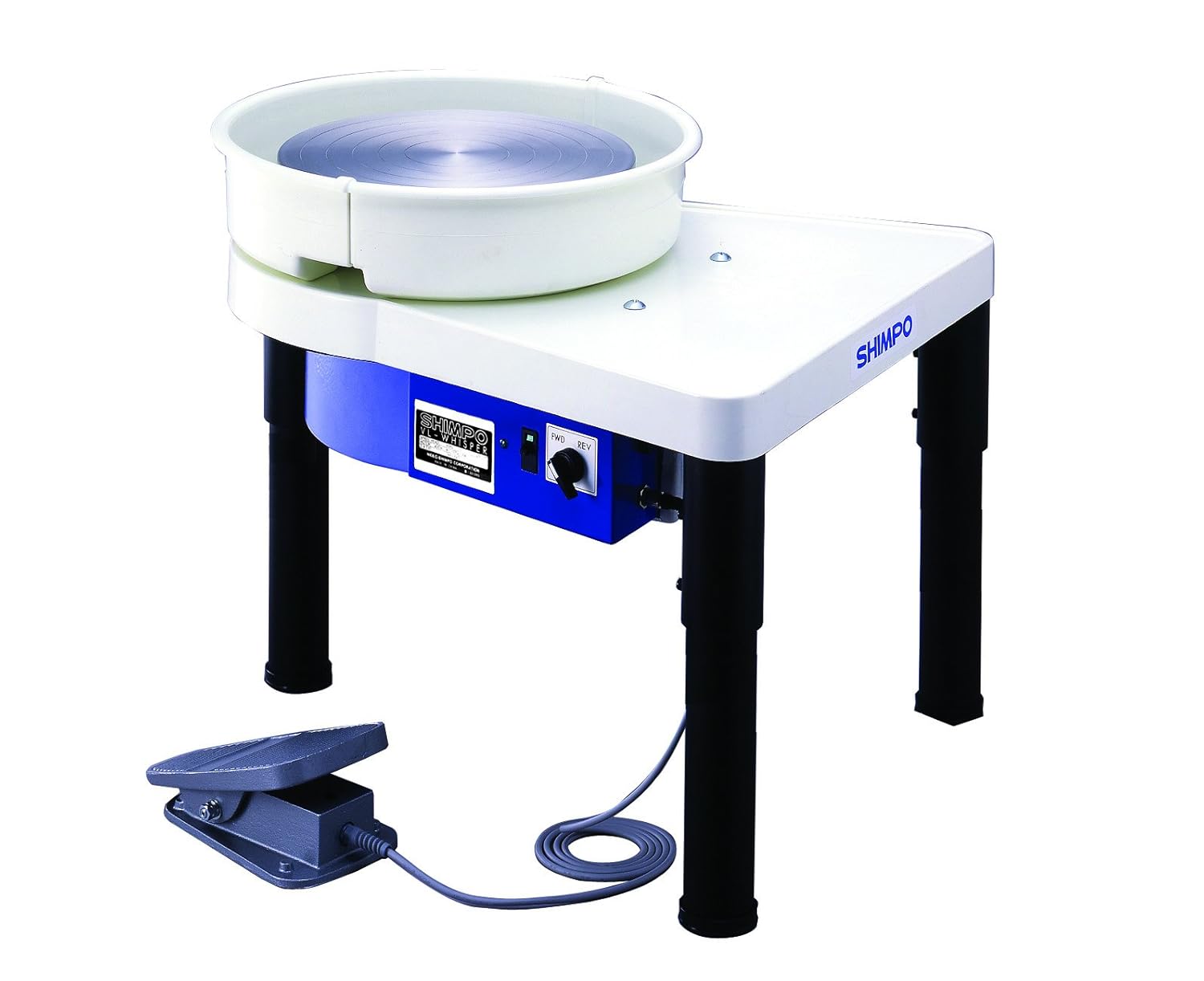
The specifications read like a production potter's wishlist: 1/2 HP brushless DC motor, 100-pound centering capacity, 14-inch wheel head, adjustable height with tripod design. The direct-drive system eliminates belts entirely - one reviewer mentions "you don't have to buy all those belts every year," revealing the hidden cost of cheaper wheels. The motor maintains exact speed regardless of pressure, a feature budget wheels can't even attempt.
- 1/2 HP (400W) brushless DC motor
- 100 lb centering capacity
- 14-inch alloy wheel head with bat pins
- 0-250 RPM with electronic speed control
- Adjustable height with tabletop position option
- Direct-drive system (no belts)
- Reversible rotation
- Remote foot pedal
- 5-year warranty
- Near-silent operation
Reviews tell a different story than the budget wheels - no mentions of wobble, no motor failures, no "worked great until..." Instead: "smooth as butter," "astronomical difference," "don't think I will need another one for a loooong time." One reviewer replaced a bent Speedball with this and called the difference "astronomical." The price point, however, places it beyond casual experimentation - this investment assumes commitment to pottery rather than curiosity about it.
The banding wheel feature - where the wheel spins freely at zero power - matters for decorating and glazing work. Budget wheels can't do this; they're either on or off. The modular components mean repairs involve replacing parts, not entire machines. The five-year warranty suggests Shimpo's confidence in their engineering. This is equipment for people who've moved past experimenting into commitment.
The Height-Adjustable Compromise: VEVOR's Mechanical Solution
The VEVOR 14-inch wheel attempts something different - solving the height problem that plagues most budget wheels. That lift-top design adjusts from ground level to 6 inches high, which sounds minor until you've spent four hours hunched over a fixed-height wheel. Your spine understands the difference immediately.
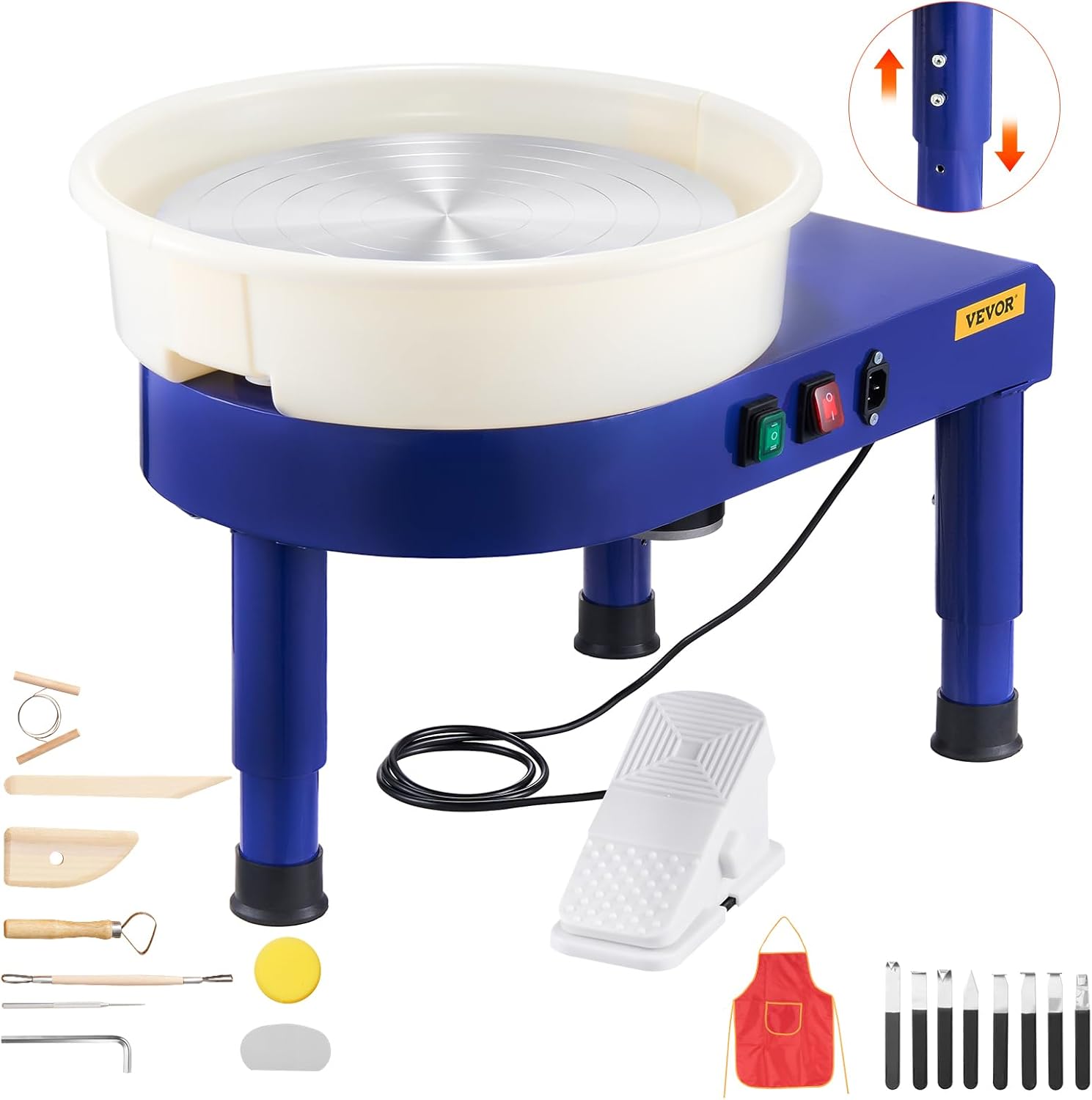
At around the $200 price mark with regular discounts, it positions itself as the ambitious amateur's choice. The 450W brushless motor promises more power than typical budget offerings, though customer reviews reveal the familiar pattern: "great for beginners" battling "wobbles with slight touch." The 14-inch aluminum turntable provides genuine working space - you could throw a serving platter if the motor cooperates.
- 14-inch aluminum alloy turntable
- 450W brushless motor
- 0-6 inch height adjustment range
- Independent foot pedal with 0-300 RPM speed control
- Reversible rotation (clockwise/counterclockwise)
- Includes 16 sculpting tools (8 steel, 8 wood)
- Detachable ABS water basin
The triangular base structure claims stability, though reviews indicate mixed results under pressure. The 60dB noise level matches a normal conversation - quieter than some budget wheels that sound like distressed appliances. The included tool set follows the universal pattern of bundled accessories: present but basic. Most users replace them after initial use.
The LCD Touch Screen Experiment: Huanyu's Digital Approach
Some pottery wheels embrace tradition. The Huanyu adds an LCD screen, as if pottery needed digital intervention. At around the $200 price point, it competes directly with the VEVOR, offering similar capacity but adding touch controls that feel transplanted from a microwave.
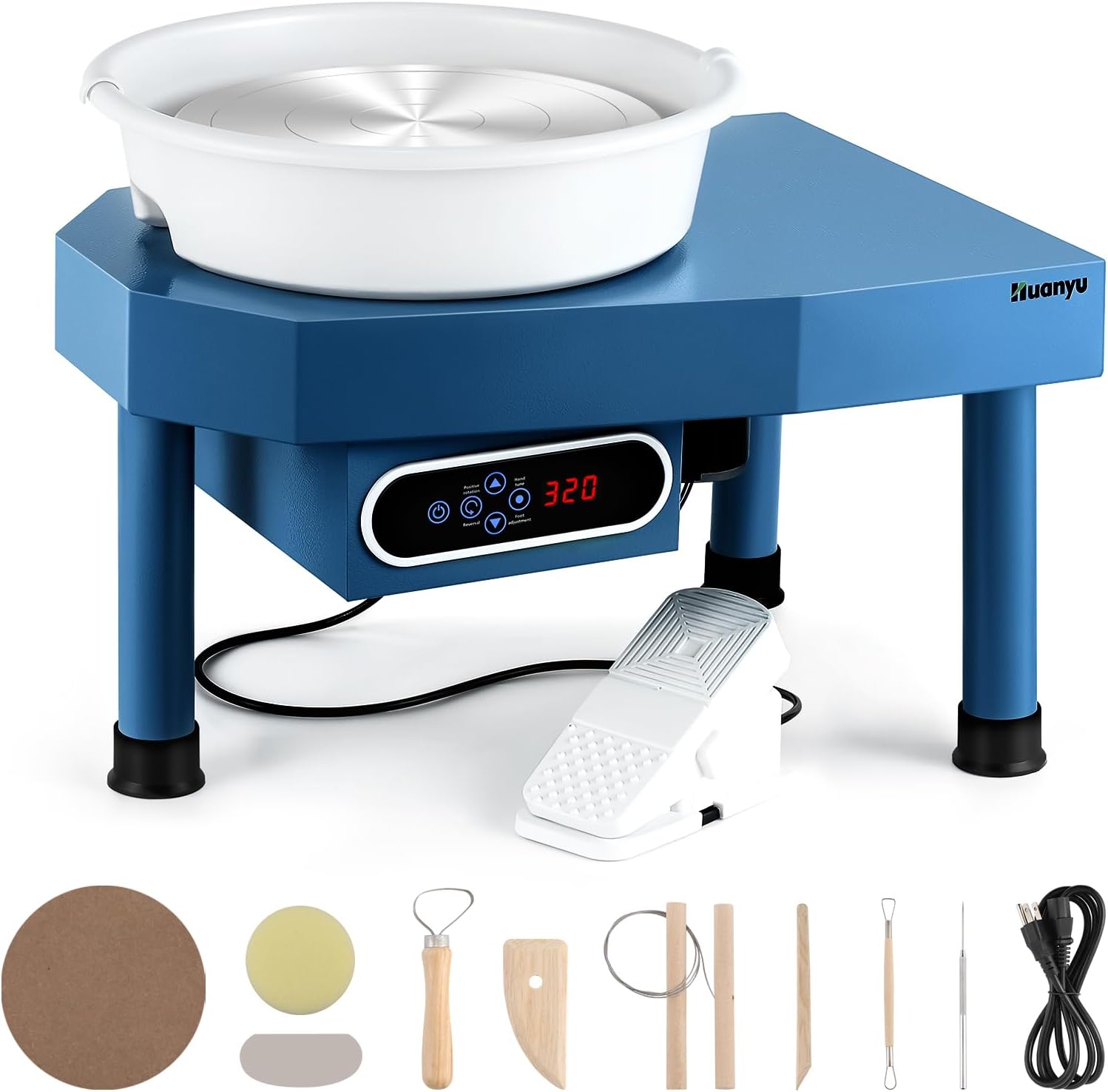
The dual control system - foot pedal or LCD touch - sounds innovative until you're covered in slip trying to adjust speed on a screen. Still, the 30cm (roughly 12-inch) aluminum turntable provides decent working space, and reviews praise its ability to handle small to medium projects without complaint.
- 30cm (12-inch) aluminum alloy turntable
- Dual speed control (pedal or LCD touch screen)
- Stepless speed regulation motor
- Forward and reverse switch
- Detachable ABS basin
- Leakage protection plug for safety
The reviews reveal the predictable dichotomy: one potter with 50 years experience finds it adequate for teaching grandchildren, while another reports the motor falling off the unit. The pedal apparently stops working "after about a month" according to multiple reviews - a timeframe suspiciously close to the return window. The company's customer service gets praise for responsiveness, which suggests they're familiar with addressing issues.
The Colorful Budget Reality: VIVOHOME's Market Position
In the budget price range for the 25cm model (often discounted), the VIVOHOME represents the true budget tier - where compromises become part of the experience. It comes in colors like a kitchen appliance: orange, blue, gray, yellow, white, pink. As if pottery needed color coordination.
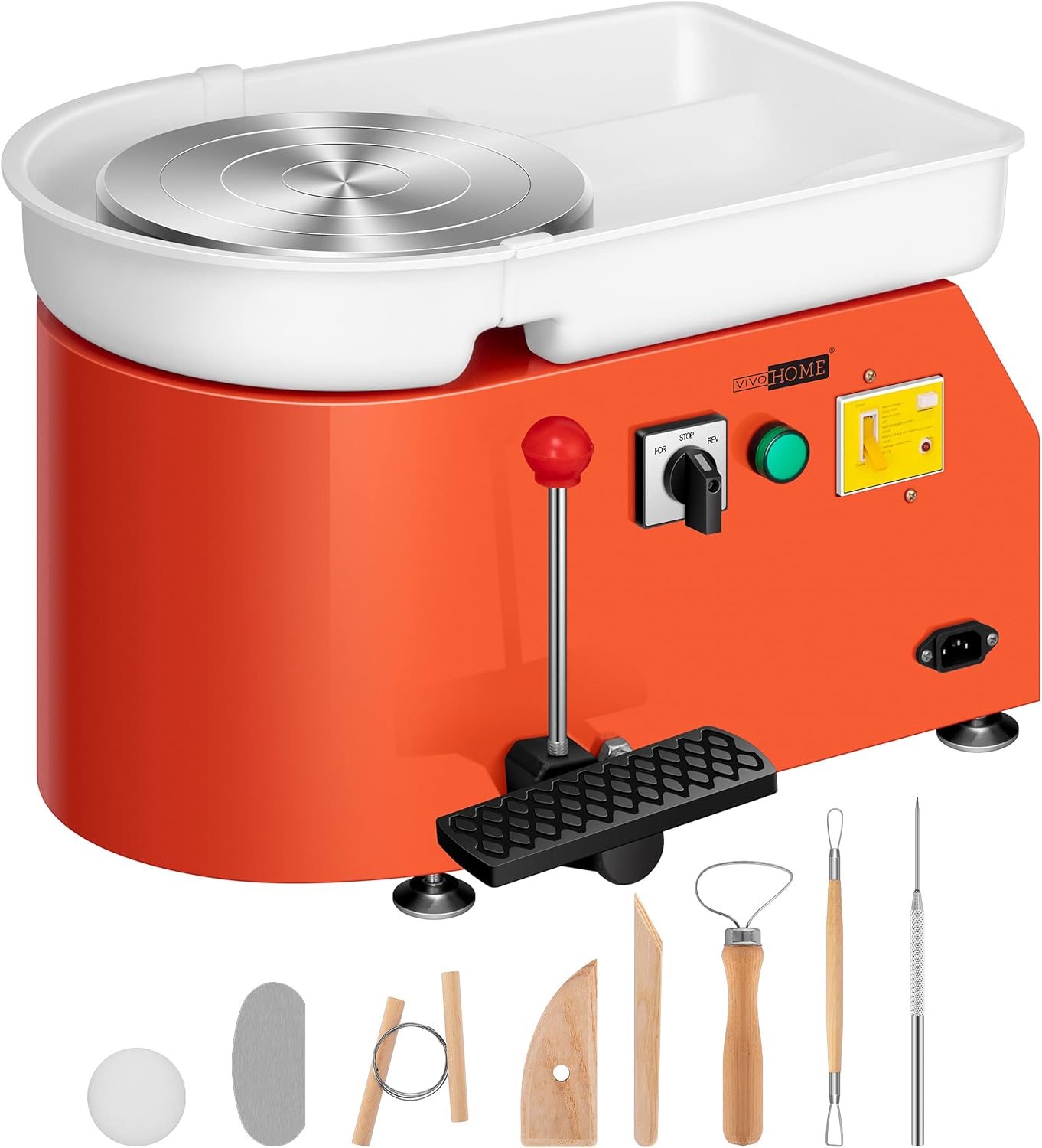
The reviews paint a familiar picture: 653 ratings averaging 4.1 stars, with the predictable split. "Good value for the price" battles "broke just after a month." One reviewer mentions their daughter loving it, another describes the collet that holds the table literally ripping apart. The machine embodies the budget pottery wheel paradox - it works until it doesn't, and that timeline varies wildly.
- 25cm or 28cm aluminum alloy turntable options
- 350W motor with 0-300 RPM speed range
- Dual control (foot pedal and hand lever)
- CE-certified safety features
- Detachable basin for easy cleaning
- Available in 6 colors
- Sub-60dB noise level
Multiple reviews mention the same specific issue: the speed lever bumps into the forward/reverse switch, causing jerky speed increases. It's the kind of design oversight that suggests nobody actually tested the machine before mass production. The wheel surface reportedly becomes "etched and pitted" with use. The splash guard gaps leak water. One reviewer plugged theirs with putty - a solution that shouldn't be necessary on new equipment.
Yet at this budget price point, people successfully throw pottery. Children make bowls. Adults explore whether clay interests them. The wheel functions as a low-commitment entry point, even if that entry point wobbles slightly and requires workarounds.
The Production Tier: Where Pottery Becomes Profession
The Brent B represents what happens when pottery wheel engineering stops compromising. At its current price point (with a manufacturer rebate often available), it's built for institutions where equipment faces daily abuse - schools, studios, anywhere pottery happens eight hours a day. The specifications read like overkill until you understand the context: 150-pound continuous centering capacity, 1/2 HP permanent magnet DC motor, ten-year warranty.
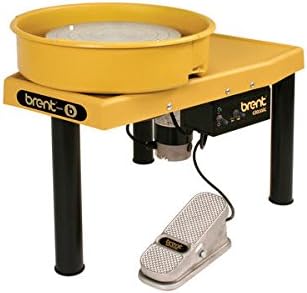
That "continuous" specification matters. Budget wheels might claim 20-pound capacity, but that's peak performance under ideal conditions. The Brent B handles 150 pounds all day, every day, without the motor even noticing. Most potters never approach these limits - which is precisely the point. Working at 10% of capacity means the machine never strains, speed never varies, torque remains constant whether you're throwing a sake cup or a garden planter.
- 1/2 HP permanent magnet DC motor
- 150 lb continuous centering capacity
- 12-inch cast aluminum wheel head with bat pins
- 0-240 RPM variable speed
- Reversible electronic speed control
- All-steel construction
- Automatic belt tensioning system
- Powder-coated legs for corrosion resistance
- Cast aluminum foot pedal
- Includes splash pan, 12" Plast-i-Bat, instructional DVD
- 10-year warranty
The Classic Controller maintains optimal torque at all speeds - the wheel speed stays constant regardless of pressure. This isn't just convenience; it's the difference between fighting your equipment and forgetting it exists. The reversible operation accommodates left-handed throwers and specific decorating techniques. The neutral safety position prevents the jarring direction changes that can destroy work on lesser wheels.
Every component assumes decades of use. Powder-coated steel legs resist studio moisture. The cast aluminum wheel head stays true after thousands of pieces. The automatic belt tensioning system maintains performance without adjustment. Even the indicator light protrudes from the control box - a tiny detail that matters when you're covered in slip trying to see if the machine's on.
The ten-year warranty tells its own story. Brent knows these machines outlast their warranties by decades. Schools still run Brents from the 1980s. Studios pass them between generations. The price reflects this permanence - you're not buying a pottery wheel, you're buying the last pottery wheel you'll need.
For most home potters, it's magnificent overkill. For production potters, teaching studios, or anyone who's moved past hobby into obsession, the math eventually works. The machine becomes invisible, letting clay become the only concern. That invisibility costs money, but it's the kind of investment that makes sense once you've destroyed your third budget wheel and realized the pattern.
Understanding Tabletop Versus Full-Size
The distinction between tabletop and full-size wheels involves more than dimensions. Tabletop wheels assume you have a surface - a table, a stand, something to place them on. That surface needs to be the right height, stable enough to handle rotating mass and pressure, and somewhere you don't mind getting covered in clay water. Many people discover they don't have that surface after buying the wheel.
Full-size wheels include their own stands or legs, eliminating the surface hunt. They position themselves at standard throwing heights. The added mass reduces vibration - 150 pounds of wheel doesn't move when you center clay. But they also claim permanent space. Once positioned, a full-size wheel tends to stay positioned.
Storage tells another story. A tabletop wheel can disappear into a closet. Full-size wheels become furniture. In a 500-square-foot apartment, that distinction matters. In a garage studio, less so.
The Motor Mathematics Nobody Explains
Horsepower ratings on pottery wheels create confusion because they measure potential, not typical use. A 1/3 HP motor can theoretically handle specific torque loads, but those calculations assume ideal conditions. In practice, motor performance depends on multiple factors: the clay's moisture content, your centering technique, how aggressively you shape, the ambient temperature, even the motor's age.
That 25-pound centering capacity on the Speedball Artista? It means the motor can maintain working speed with 25 pounds of clay under normal pressure. Push harder, the motor slows. Push much harder, it might stop entirely. The budget wheels claiming 20-pound capacities often use optimistic math. Their motors slow noticeably with 10 pounds of clay under real working pressure.
Professional wheels like the Brent B, with its 150-pound continuous capacity, never experience this. You physically cannot apply enough pressure to stress the motor. It's like driving a diesel truck - the power reserve exceeds any demand you'll make. This overhead translates to consistency. The wheel spins at exactly the speed you set, regardless of what you're doing to the clay.
What Forward and Reverse Actually Does
Reversible motors appear on mid-range and professional wheels, absent from most budget options. The feature sounds minor until you understand its applications. Most throwers work with counter-clockwise rotation - it's how most people learned, how most instruction assumes you're working. Left-handed throwers sometimes prefer clockwise, though not always.
But reverse transcends handedness. Trimming feet on bowls often works better in reverse - you're cutting into the clay rather than across it. Certain surface decoration techniques require direction changes. Some glazing applications benefit from reverse spinning. Professional potters use reverse regularly. Beginners might not touch it for months, then discover it solves a specific problem they've been fighting.
The mechanical difference matters too. Wheels with reverse capability use different motor designs - usually permanent magnet DC motors rather than simpler AC motors. These motors provide better torque control, smoother speed transitions, and longer service lives. The reverse switch indicates better overall construction, not just directional options.
The Cleanup Reality
Nobody discusses cleanup in pottery wheel marketing, but you'll spend nearly as much time cleaning as throwing. Fixed splash pans - standard on budget wheels - turn cleaning into excavation. Clay accumulates in corners. Slip builds up in crevices. You're scraping, sponging, sometimes disassembling things to reach trapped clay.
Removable splash pans change the entire process. Lift away the pan, carry it to a sink, clean it properly. The Speedball Artista, Shimpo VL-Whisper, and Brent B all use removable designs. Some take it further with two-piece systems that come apart completely. Five minutes versus twenty minutes, multiplied by every session.
The wheel head surface affects cleaning too. Smooth aluminum cleans easily but shows every mark. Textured surfaces hide wear but trap clay. The concentric circles on budget wheels - machining marks, really - create countless tiny channels where clay lodges. Premium wheels machine their surfaces smooth or use specific textures designed for easy cleaning.
The Noise Factor
Pottery wheels generate two types of noise: motor noise and mechanical noise. Motor noise comes from the motor itself - electrical hum, bearing sounds, ventilation fans. Mechanical noise comes from power transmission - belts, gears, vibrations. Budget wheels often produce both. You'll hear the motor laboring and feel vibrations through whatever surface supports the wheel.
Quality wheels run remarkably quiet. The Shimpo VL-Whisper lives up to its name - near silence. The Brent B uses systems that minimize gear noise. The Speedball Artista falls between - some motor noise but nothing overwhelming. In a shared space, noise matters. In a garage studio, less so.
Noise also indicates problems. A wheel that starts quiet but develops noise needs attention - bearings wearing, belts loosening, something coming apart. Budget wheels often arrive noisy and get worse. Premium wheels start quiet and stay quiet for decades with basic maintenance.
Different wheels create different learning experiences. Hand-controlled wheels let users focus entirely on the clay initially - one less variable while learning to center. Foot pedals add coordination requirements but free both hands for working. Most instructors start students with hand control, transitioning to foot control after basic skills develop.
Wheel height affects the throwing experience. Low positioning causes hunching, creating back strain alongside clay work. High positioning reduces leverage. Adjustable height wheels like the VEVOR and Shimpo VL-Whisper allow position optimization. Fixed-height wheels require user adaptation. Tabletop wheels depend on surface height.
Centering capacity often misleads beginners. A 25-pound capacity doesn't mean starting with 25 pounds makes sense. Most instruction begins with one or two pounds - enough for a small bowl or cup. The capacity rating indicates maximum capability, not typical use. Even experienced throwers rarely work near maximum capacity.
The Tool Reality
Every budget wheel includes tools. They're typically basic - pot metal that bends, wires that snap, ribs that flex rather than shape. Most users replace them immediately. Included tools function more as starter equipment than long-term solutions.
The VEVOR includes 16 tools (8 steel, 8 wood), which sounds generous until tested in practice. The Shimpo and Brent ship without tools - their market already owns preferred equipment.
Basic functional tools cost around the $30-50 range - a few ribs, proper wire, needle tool, trimming tools, sponges. Professional tools can reach hundreds, reflecting personal preference. Tool quality affects the throwing experience significantly. Working with inadequate tools creates unnecessary challenges.
The Time Investment Truth
Pottery wheels imply time commitments that marketing never mentions. Learning to center clay takes most people 20-30 hours of practice. Throwing basic forms consistently: another 50 hours. Developing personal style: hundreds of hours. The wheel becomes a relationship, not an activity.
Budget wheels that break after two months interrupt that relationship. You're relearning on new equipment instead of progressing on familiar equipment. Premium wheels maintain consistency for decades - muscle memory develops, techniques refine, the machine becomes extension rather than obstacle.
This explains the market split. Casual experimenters can accept disposable equipment. Committed learners need reliability. Production potters require absolute dependability. Price points reflect these different relationships with time.
The Space You Actually Need
Marketing photos show pottery wheels in pristine studios with perfect lighting. Reality involves different calculations. The wheel needs space. You need space around the wheel - reaching for tools, moving around while working, avoiding walls while centering. Clay storage takes space. Drying work takes space. Tool storage, glazes, kiln access - pottery expands to fill available space.
Minimum functional space: about 6 feet by 6 feet, including wheel, chair, tool access, and movement room. Comfortable space doubles that. Tabletop wheels seem space-efficient until you factor in table requirements, surrounding access, and the same tool/clay/work storage needs.
Some people successfully throw in closets, bathrooms, kitchen corners. Others build dedicated studios. The wheel purchase often catalyzes space reorganization. That $117 experiment becomes room transformation.
Making Sense of the Market
The pottery wheel market reflects different philosophies rather than linear quality tiers.
The experimental tier (around the sub-$200 range) offers discovery without major investment. Motors strain, wheels wobble, components break, but clay still forms. The VIVOHOME occupies this space - functional enough for learning, fragile enough to reveal what features matter in practice.
The working middle (around the $400-600 range) balances capability with cost. The Speedball Artista represents this tier - actual pottery equipment without crushing expense. It handles what most home potters create. It lasts years rather than months. Its limitations don't prevent skill development.
The professional bridge (in the $800-1,500 range) targets serious hobbyists and semi-professionals. The Shimpo VL-Whisper exemplifies this category - whisper-quiet operation, direct-drive reliability, features that matter once skills develop. The price reflects engineering that becomes invisible during use.
The production tier (above the $1,500 mark) assumes institutional use. The Brent B and similar models build for decades of daily operation. The price reflects industrial-grade construction. Production potters, teaching studios, and committed practitioners find the investment proportional to use.
Each tier serves specific needs. Mismatches occur when equipment doesn't align with intended use - a VIVOHOME for serious study or a Brent B for casual exploration. Understanding current skill level and future intentions clarifies which specifications matter.
The ceramics teacher with her ancient Brent demonstrated something marketing rarely mentions: equipment quality affects the throwing experience but doesn't determine it. She could work on a VIVOHOME if necessary. But equipment that operates consistently, without surprises or interruptions, creates space for focus on the clay itself. The wheel becomes transparent to the process rather than central to it.
That transparency reflects what these price differences actually represent: not just specifications or features, but the quality of interaction the wheel enables. Budget wheels require attention to their limitations. Premium wheels fade into background, letting clay work become primary. The price gap reflects that operational difference more than any horsepower rating or centering capacity.
The market sorts itself accordingly.